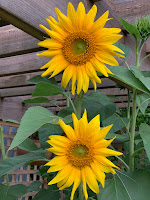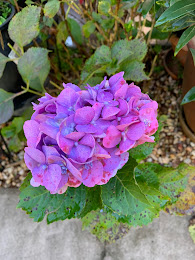This white hydrangea is always the first hydrangea to come into flower in Spring. My garden has more than a dozen beautiful hydrangeas, but only one that is white. When I bought the house it was midwinter and these plants had been given their winter trim so they were not much to look at. I actually thought I might remove them once I'd moved in, since I associate them with cool climates and don't usually grow anything that I think is wrong for this climate. For example, I know I'd never be able to grow them as beautifully as I did in Tasmania.
Luckily, I didn't move into this house until early summer, months later, because I went overseas on assignment right after I signed the contract. When I finally did move in, I was blown away by the beauty of the hydrangeas in full flower. Most of them are planted along a south-facing wall, and get no sun at all in the hottest months and only weak morning sun in winter. They are also planted up close to the house, and the roof's overhanging eaves shelter them from getting too drenched in our tropical summer downpours. Hydrangeas don't like hot sun or wet feet and mine are protected from both.
Among the predominantly blue hydrangeas, few of which are yet in bloom, I have this one white-flowering one. I don't know if it flowers first because it's white or because it happens to get an hour or two of sun - the only hydrangea that does in Spring.
White hydrangeas, as any gardener knows, always stay white. And they're prized for that, so my Garden Club friends are always pleased to get cuttings when I prune. Blue-flowering plants, on the other hand, will be blue, pink or some mixture of both, including shades of mauve, depending on soil ph. Red or pink blooms result from neutral or basic soil (pH 7 and above), whereas blue blooms indicate acidic soil condition (pH less than 7). Apparently the color is not determined by the pH itself, but by the amount of aluminium a plant can access in the soil - and that is what is determined by pH and phosphorus levels.
In one of my first years here, my grand-child and I tried an experiment. My hydrangeas then were mainly blue (except for the white one, of course.) So Charlie and I gave every second blue-flowering plant a good dose of garden lime. That should have produced pink flowers. It wasn't a great success in the that year, but ever since then I have had a nice variety of colours, including different shades of blue and some mauve streaks.
I like the blue ones best, though, so this year I'm going to give them a liquid fertiliser called Hydrangea Blue (which probably contains aluminium sulfate). That's on my shopping list for the next visit to Bunnings! However, I've already given them all a good dose of mushroom compost, which I suspect is a bit acidic. So anything could happen.
These photos show the hydrangeas some years ago, before we tried making some turn pink. The two close-up photos feature a few of our pink results a couple of years later. It will be interesting to see what turns up this year!







No comments:
Post a Comment